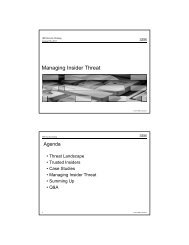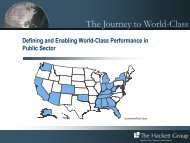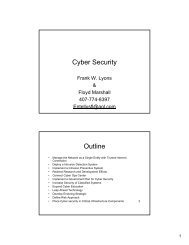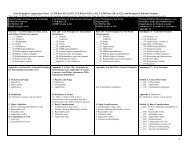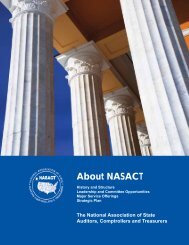Advisory Committee on Tax Exempt and Government Entities (ACT ...
Advisory Committee on Tax Exempt and Government Entities (ACT ...
Advisory Committee on Tax Exempt and Government Entities (ACT ...
You also want an ePaper? Increase the reach of your titles
YUMPU automatically turns print PDFs into web optimized ePapers that Google loves.
The Appropriate Role Of The Internal Revenue Service With Respect To <strong>Tax</strong>-<strong>Exempt</strong> Organizati<strong>on</strong> Good Governance Issuesoccurrences in the future. 40 As noted previously, the current period of intense scrutinywith respect to governance relates back to Enr<strong>on</strong> <strong>and</strong> other corporate sc<strong>and</strong>als <strong>and</strong>C<strong>on</strong>gress’ subsequent enactment of SOX. In fact, much of the discussi<strong>on</strong> of “bestpractices” in the n<strong>on</strong>profit sector since that time has focused <strong>on</strong> the extent to whichSOX-type reforms (sometimes broadened to include related changes to the exchangerules) should be adopted—or required—of n<strong>on</strong>profit corporati<strong>on</strong>s. 41Professor Robert Clark of Harvard University, in a 2005 paper, 42 reviewed the empiricalstudies then to date involving publicly-traded corporati<strong>on</strong>s <strong>and</strong> their adopti<strong>on</strong> of SOXtypegovernance measures, such as independent directors, secti<strong>on</strong> 404 internalc<strong>on</strong>trols, an independent audit committee, <strong>and</strong> restricting n<strong>on</strong>-audit services provided bythe auditing firm, <strong>and</strong> c<strong>on</strong>cluded that “the search for str<strong>on</strong>g empirical evidencesupporting a belief that key items in the recent wave of corporate governance changeswill have a major positive impact is generally disappointing.” 43 He also examined thespecific “good governance practices” advocated by the rating agencies, such as asupermajority of independent directors, a relatively small board size, a separate (i.e.,independent, n<strong>on</strong>-CEO) board chairman, a specified number <strong>and</strong> length of meetings,regular executive sessi<strong>on</strong>s (at which company officers are not present), regularevaluati<strong>on</strong>s of the CEO, regular self-evaluati<strong>on</strong>s of the board, minimum stock ownershiprequirements for directors, <strong>and</strong> limits <strong>on</strong> director tenure (term limits <strong>and</strong>/or retirementages). Citing a plethora of studies examining these <strong>and</strong> similar “good practices,”Professor Clark c<strong>on</strong>cluded: “For most of these practices, the empirical evidence bearing<strong>on</strong> their correlati<strong>on</strong> with shareholder value is limited or mixed or both, <strong>and</strong> does notprove decisively that they cause increases in value.” 44In some sense, this is not surprising. For example, <strong>on</strong> paper, Enr<strong>on</strong> had in place arigorous c<strong>on</strong>flict of interest policy <strong>and</strong> other c<strong>on</strong>trols. The problems at Enr<strong>on</strong> related toimplementati<strong>on</strong>, including the board not dem<strong>and</strong>ing or ensuring it understood thepertinent informati<strong>on</strong>, the board waiving c<strong>on</strong>flicts that should not have been waived, <strong>and</strong>the board not resp<strong>on</strong>ding appropriately <strong>on</strong>ce problems began to emerge. 45 Anecdotal40See Appendix 2 for a discussi<strong>on</strong> of for-profit corporate governance. The enactment of groundbreaking federal securities lawsoften was prompted by profound failure or crisis.41See, e.g., Paul D. Brode & Richard L. Prebil, The Impact of Sarbanes-Oxley <strong>on</strong> Private & N<strong>on</strong>profit Companies (Nati<strong>on</strong>al DirectorsInstitute 2005); Carl Oxholm III, Sarbanes-Oxley in Higher Educati<strong>on</strong>: Bringing Corporate America’s “Best Practices” to Academia,31 J.C. & U.L. 351 (2005); Moody’s Investor Services, Governance of Not-for-Profit Healthcare Organizati<strong>on</strong> (2005); Fitch Ratings,Sarbanes-Oxley <strong>and</strong> Not-For-Profit Hospitals: Increased Transparency <strong>and</strong> Improved Accountability (2005); St<strong>and</strong>ard & Poor’s,Under Legislative Scrutiny, The U.S. N<strong>on</strong>profit Sector Embraces Corporate-Style Oversight (2005) <strong>and</strong> “Research: U.S. Not-for-Profit Health Care Sector Explores the Benefits of Sarbanes-Oxley Compliance (2005). See also ABA Coordinating <str<strong>on</strong>g>Committee</str<strong>on</strong>g> <strong>on</strong>N<strong>on</strong>profit Governance, supra note 16.42Robert Charles Clark, Corporate Governance Changes in the Wake of the Sarbanes-Oxley Act: A Morality Tale for PolicymakersToo, 22 Ga. St. U.L. Rev. 251 (2005). See also Roberta Romano, The Sarbanes-Oxley Act <strong>and</strong> the Making of Quack CorporateGovernance, 114 Yale L.J. 1521 (2005).43Clark, supra note 43, at 308. The <strong>on</strong>e excepti<strong>on</strong> involved disclosure, which he found to be positively correlated with reducing thevolatility of stocks. Id. at 304-05.44Id. at 303.45See William Powers, Jr., Chairman of the Special Investigati<strong>on</strong> <str<strong>on</strong>g>Committee</str<strong>on</strong>g>, Report of Investigati<strong>on</strong> by the Special Investigative<str<strong>on</strong>g>Committee</str<strong>on</strong>g> of the Board of Directors of Enr<strong>on</strong> Corp. (Feb. 1, 2002), at 148:ADVISORY COMMITTEE ON TAX EXEMPT AND GOVERNMENT ENTITIES (<strong>ACT</strong>) June 11, 2008 16






